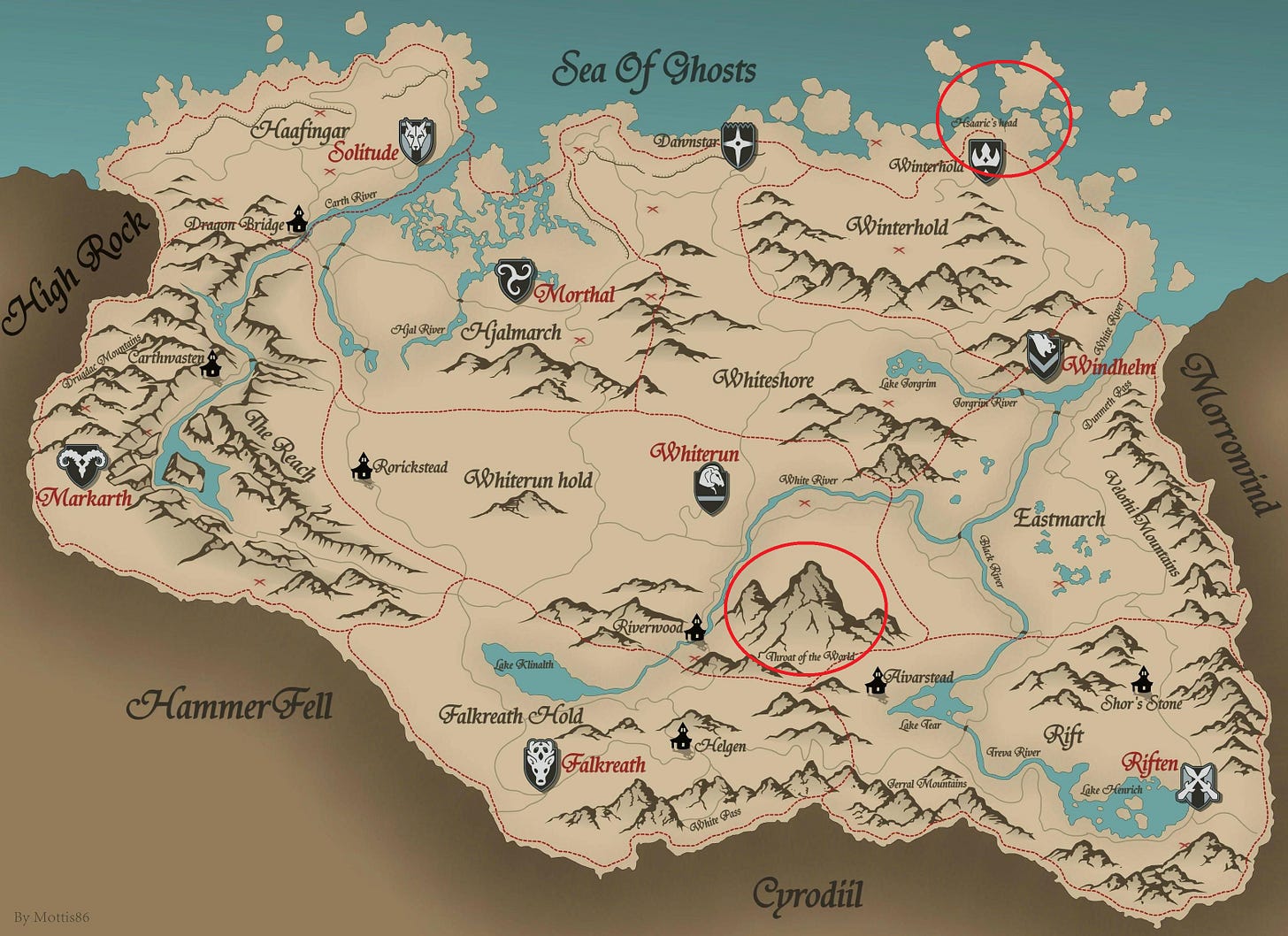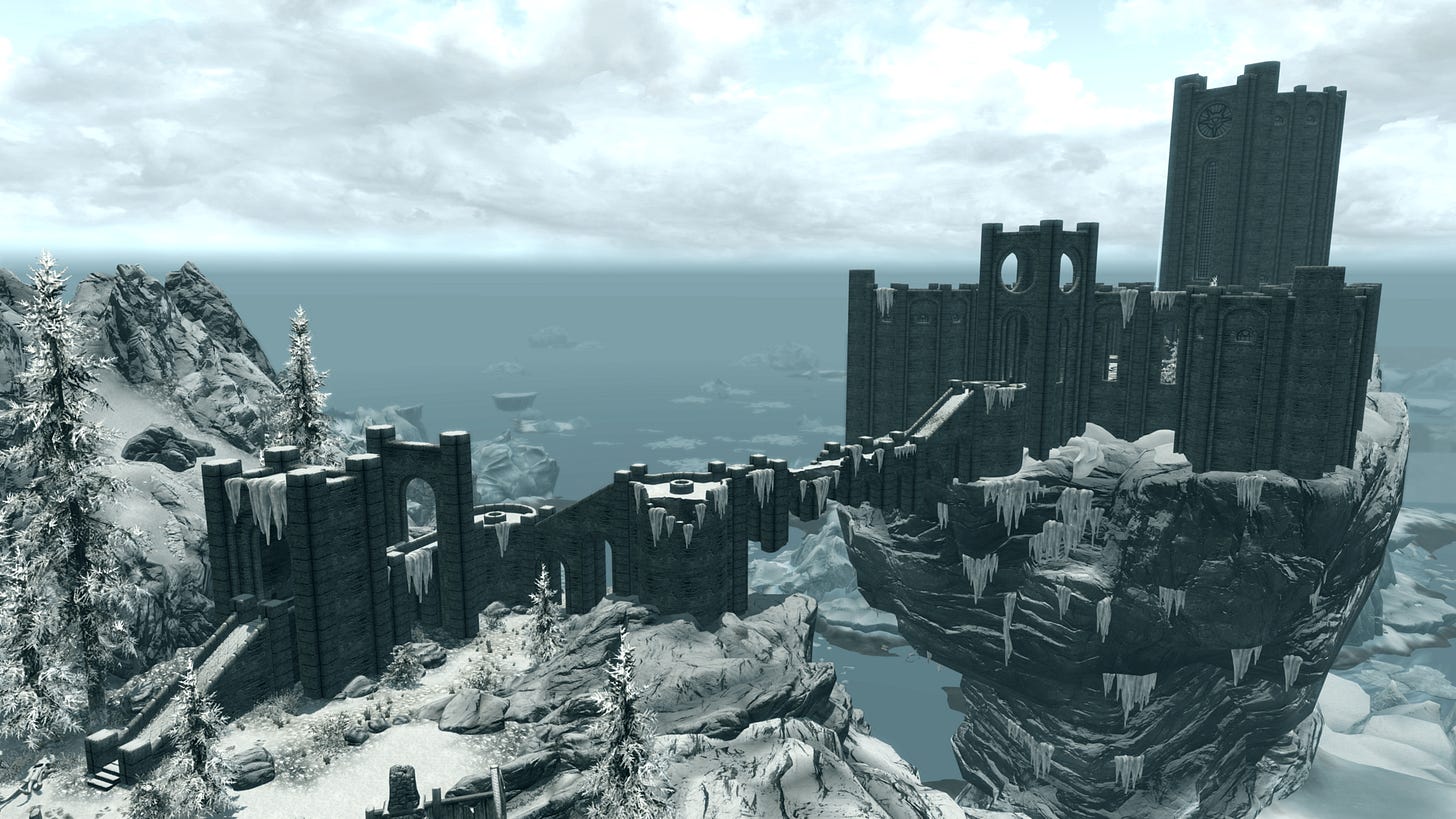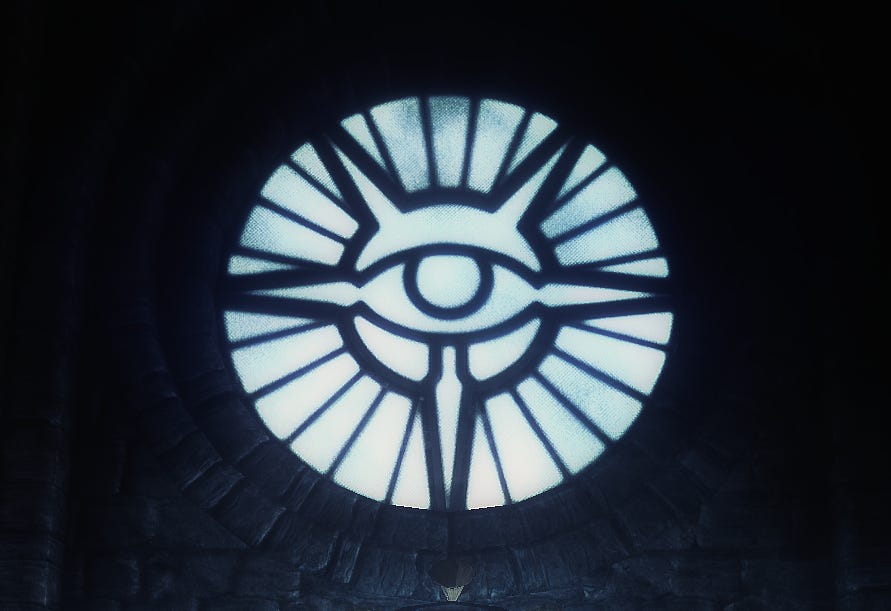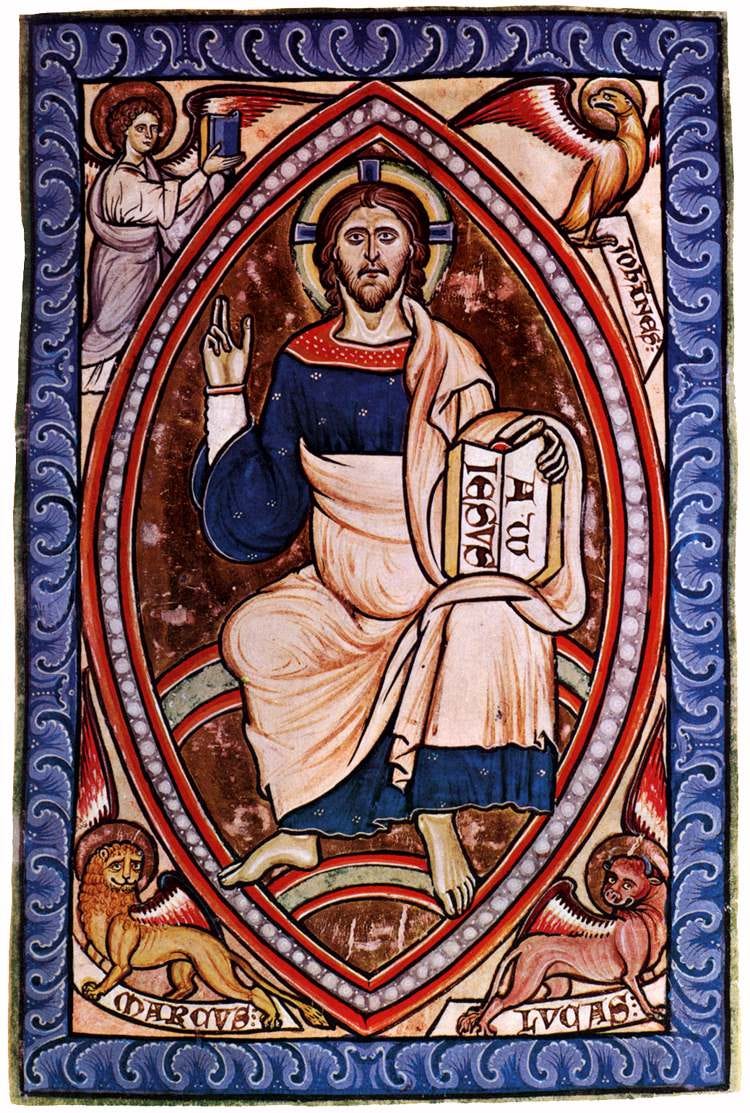Symbolism in Skyrim: Magic and the Mages College
Symbolism surrounding the Mages College in Skyrim and its connections with science, materialism and pride.
In this post I will discuss some symbolism in Skyrim surrounding magic, in particular the Mages College of Winterhold.
It’s said in Skyrim that Shouts are an old form of magic. Emphasis on old. As I mentioned in my previous post, Shouting in Skyrim is not exactly associated with wizardry in the normal, superficial sense. I would argue that compared with casting spells, Shouting is relatively closer to language in the Christian sense: finding and uniting oneself with “logoi” in the world. That is, each Word of Power in Skyrim describes and embodies an aspect of reality which one must encounter both corporeally and spiritually, in a physical encounter as well as in spiritual understanding.1
To help see the difference between common magic and the Voice let us compare Winterhold’s Mages College with High Hrothgar. The former is where the player can go to formally practice magic and the latter is where the Greybeards (who practice the Voice) reside. From a symbolic perspective we would expect each’s location and structure to be outward expressions of their respective inner purposes.
Location
Both the College as well as High Hrothgar are places of seclusion, focus and study, but they are qualitatively different in what they pursue. I would say the College of Winterhold is about gaining magical knowledge in an almost scientific sense while High Hrothgar is rather a fortress, which serves the purpose of a monastery. Already this is almost all we need to know to appreciate the difference between magic and the Voice, but let’s break it down.
The College is a school, a playground for talented mages to do research and “experimentation” with shared resources and under certain socially agreed upon constraints. In contrast, High Hrothgar is borderline hostile to visitors and newcomers, nor is it a place for innovation or experimentation, rather its purpose is for a small brotherhood of monks to engage in withdrawn worship and contemplation of the ancient language of the Voice. If the Mages College is a monument of the will and intellect, High Hrothgar would be the spiritual or religious equivalent. The College aims to go upward and outward into novelty, while the monastery aims to go upward and inward. This is reflected in the physical locations of each. The Mages College is in the northern edge of Skyrim, reaching out into the unknown of the chaotic ocean, while High Hrothgar is at the heart of Skyrim, on its highest mountain.

Furthermore, the College is on an island that’s broken off from the mainland, and to get there you must not only travel across the whole icy north of Skyrim, but also across a thin, broken bridge.
Just as with climbing a mountain, this reflects its own sort of focus, or “asceticism”. One must constrain oneself on the “narrow path” in order to gain competence in a specific direction, moving from one world (the world of Nordic muggles) to another (the world of magic).
Although they’re similar in terms of being expressions of transformation, crossing a bridge is symbolically still different from ascending a mountain. Understanding the implications of this for the College and High Hrothgar respectively will further emphasize for us the difference between magic and Shouting.
Crossing a bridge from a mainland to an island is a sort of specialization. It’s a departure from what’s full yet undifferentiated. One narrows one’s view in order to make it sharp, like sharpening a knife so it can be more “pointed” and effective. This is the scientific kind of thinking that underlies our current secular conception of education. We have different fields of specialization (physics, chemistry, biology etc.) that we see as more or less discrete and capable of being independently studied, just as there are different schools of magic (alteration, conjuration, destruction etc.), and even the elements themselves (fire, frost and shock) wherein one can specialize. The emphasis in this is different than that of a spiritual path, which might consist of different aspects and applications (reading Scripture, prayer, fasting, almsgiving etc.) but it would be inconceivable for a monk to overly “specialize” in any one aspect at the cost of others. A monk whose special power is fasting, at the cost of engaging Scripture and prayer, is not a monk at all, but simply someone who is dieting. So there is more emphasis on a general ascension using all the different spiritual tools in a rhythmic, liturgical fashion. And so we see in Skyrim that approaching High Hrothgar is nothing like going across a bridge, rather it’s circumambulation around and towards a central upper point. And so, just as with the location of each institution - how one gets to them is also of relevance. The College demands one to move in one narrow direction horizontally, while High Hrothgar demands moving up vertically by circumambulation.
The Modern University
Already I have said that the College is reminiscent to the pointed exploratory spirit we see in the scientific mentality today. And anyone playing the game will quickly notice the similarities between the College and modern universities. The mages there are concerned with accumulating more magical knowledge (in a quantitative sense), taking for granted that that’s a worthwhile pursuit. Characters often speak as if magical knowledge justifies itself. To be frank, I’ve played the College quests and noticed the perspective to be markedly alienating. There is a general tendency to turn everything into something to be studied and carefully taken apart, and of course there is also a strong desire for power, but that’s a story for another day.
Science today tends towards this as well; the spirit of science wishes to shine light on mysteries (going into the unknown of the chaotic ocean) in a manner to explain them and through this insight grow in body, in ability. The Greybeards wish to grow in their Thu’um and they participate in fervent practice, but they are not scientists, sceptics or explorers, their purpose is not to expand themselves outward in action, but rather, as Master Arngeir says, mastery of the Thu’um only happens “when the inner spirit is in harmony with outer actions”. That’s a very different project.
Symbols around the College
Let’s look now at the different explicit symbols around the College that will confirm the connection between magic in Skyrim and the materialist worldview.
There is a statue in the central courtyard of the College. A cloaked mage has arms outstretched, palms facing up, in front of a blue fiery light that reaches towards the heavens. This blue fire lights up most places around the College and is most impressively found in the main hall and tower of the College, called the Hall of the Elements.
Another prevalent symbol representing the College is a pointed kind of upside down pentagram, with an eye at the centre.
These images are quite telling as to what the College stands for. First of all, there is a strong emphasis on pointed light and sight, as one might expect from an institution that venerates knowledge as such. Obviously light is all about unveiling darkness. It is the world laid bare, made explicit, sober even. This last image of the eye is especially powerful because it is a window, that is, the symbol of the eye is revealed by light moving through it, just as seeing itself happens. Furthermore the pentagram’s spokes are pointy. The pointedness of everything associated with magic (including the wand or the staff) is easy to understand in the context of magic being “rational” - having a “point”, a purpose, end goal. It is about the will and intelligence of man becoming directly manifest in the world (as opposed to irrationality, which involves randomness and loss of control or surrendering through faith).2
To understand the pentagram as a symbol is a task on its own, so I’ll try to keep my perspective here brief. My ideas are mostly derived from Jonathan Pageau’s thoughts on the subject. In the image below I have drawn a red square. And indeed you might notice that all these spokes are continuous with the eye unlike the bottom spoke, which is separated by a black line.

Four is a stable number - most terrestrial animals walk on four legs, and likewise chairs, tables, cabinets etc. most typically rest on four legs as well. The “fourness” of things go together with stability and an encounter with the earth. There are also four main directions and four squares on a cartesian plane. And rooms consist of four walls, forming the bottom part of a building. In Christianity there are four evangelists and their four gospels, portrayed in the image we call “Christ in Glory” where Christ is surrounded by four beasts at his extremities, representing the evangelists in their divergent particularities.
The idea is one of emergence. You have these divergent outward earthly manifestations, the lion, the bull, the eagle and man, that hold together in the unity of the Universal Man, their origin and purpose - Christ who is God incarnate. The idea is that multiplicity below can be the body, the seat, of a higher unity that binds them to heaven. If you see this image in three dimensions, with the four animals on the same plane in the background, and Christ in the foreground - it is basically also a pentagram. Of course Orthodox churches also have this architecture, consisting of walls forming a square that supports a dome, wherein Christ is painted.
The inverted pentagram is the opposite idea: that one could use multiplicity, divergent earthly manifestations, to concentrate a power below. Understandably then the inverted pentagram has also become associated with Satanism, and, to be honest, democracy, albeit much less explicitly. But I’ll leave it to you to watch Jonathan Pageau’s videos on this so I can focus on the application to Skyrim.3 The idea with the Mages College is maybe that there are the different branches of magic, which the mage concentrates in himself by rational knowledge (light, the eye), granting him otherworldly power. And there is no higher meaning beyond the elements themselves. Mages do not associate with a god or a mission that unites them, they are not working towards a common goal besides the very idea of power and knowledge itself, in all its divergent manifestations. This is different from the image of Christ, because Christ does not venerate the extremities in order to gain power, they venerate Him. But magic and materialist rationality ignore God and rather focus on earthly things, making them supreme, and then concentrating power in the self. Obviously this is very much also the task of science, and modern politics.4 In this understanding of the pentagram we can also better understand the first image, of the cloaked mage in front of the brazier. It is similar to the pentagram. The mage is covered, hidden under the cloak, he is the bottom spoke. Then with the pointy light, you can see it both ways, happening simultaneously: the mage venerates the light, lifting it up from the ground to the heavens and at the same time the light comes down from heaven and concentrates on the earth. Either way his attention is on the light, which represents knowledge/insight (the eye) since it connects heaven and earth and is pointy (rational). The “hall of the elements” completes this image, since the “elements” are the divergent spokes of the pentagram.
Perhaps in a follow-up post I could go more into the details and implications of the College quests in the game. But already it’s easy to intuit the costs of this mentality. If one fetishizes rational knowledge over other values, it’s not surprising that it might lead to things like surveillance, uncontrollable power, pride, and what they called the Great Collapse… Stay tuned.
The spiritual aspect comes through meditation on the meaning of Words and years of practice, as is the Greybeards’ approach, or if you’re born with dragon blood (that is, if you’re chosen by the gods) then you exert spiritual mastery by absorbing the souls of dragons/principalities spontaneously.
For those who haven’t watched it yet, Jonathan Pageau’s video on 666 will be informative:
Here is Jonathan Pageau’s analysis of the inverted pentagram. Also check out his analysis of Lil Nas X’s satanic music video, Montero.
In the ancient world there is a strong connection between this kind of magic and advanced technology. The recent Marvel movie Eternals actually explores this idea. It’s also easy to see from a phenomenological perspective, since most people don’t know the details of how technological devices work.








